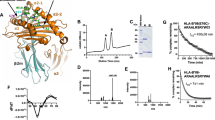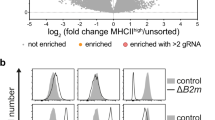Abstract
Major histocompatibility complex (MHC) class I molecules present thousands of peptides to allow CD8+ T cells to detect abnormal intracellular proteins. The antigen-processing pathway for generating peptides begins in the cytoplasm, and the MHC molecules are loaded in the endoplasmic reticulum. However, the nature of peptide pool in the endoplasmic reticulum and the proteolytic events that occur in this compartment are unclear. We addressed these issues by generating mice lacking the endoplasmic reticulum aminopeptidase associated with antigen processing (ERAAP). We found that loss of ERAAP disrupted the generation of naturally processed peptides in the endoplasmic reticulum, decreased the stability of peptide–MHC class I complexes and diminished CD8+ T cell responses. Thus, trimming of antigenic peptides by ERAAP in the endoplasmic reticulum is essential for the generation of the normal repertoire of processed peptides.
This is a preview of subscription content, access via your institution
Access options
Subscribe to this journal
Receive 12 print issues and online access
$209.00 per year
only $17.42 per issue
Buy this article
- Purchase on Springer Link
- Instant access to full article PDF
Prices may be subject to local taxes which are calculated during checkout








Similar content being viewed by others
References
Shastri, N., Schwab, S. & Serwold, T. Producing nature's gene-chips. The generation of peptides for display by MHC class I molecules. Annu. Rev. Immunol. 20, 463–493 (2002).
Falk, K., Rotzschke, O., Stevanovic, S., Jung, G. & Rammensee, H-G. Allele-specific motifs revealed by sequencing of self-peptides eluted from MHC molecules. Nature 351, 290–296 (1991).
Townsend, A.R., Bastin, J., Gould, K. & Brownlee, G.G. Cytotoxic T lymphocytes recognize influenza haemagglutinin that lacks a signal sequence. Nature 324, 575–577 (1986).
Attaya, M. et al. Ham-2 corrects the class I antigen-processing defect in RMA-S cells. Nature 355, 647–649 (1992).
Yewdell, J.W., Reits, E. & Neefjes, J. Making sense of mass destruction: quantitating MHC class I antigen presentation. Nat. Rev. Immunol. 3, 952–961 (2003).
Rock, K.L., York, I.A., Saric, T. & Goldberg, A.L. Protein degradation and the generation of MHC class I-presented peptides. Adv. Immunol. 80, 1–70 (2002).
Kloetzel, P.M. Generation of major histocompatibility complex class I antigens: functional interplay between proteasomes and TPPII. Nat. Immunol. 5, 661–669 (2004).
Falk, K., Rötzschke, O. & Rammensee, H.G. Cellular peptide composition governed by major histocompatibility complex class I molecules. Nature 348, 248–251 (1990).
Serwold, T., Gaw, S. & Shastri, N. ER aminopeptidases generate a unique pool of peptides for MHC class I molecules. Nat. Immunol. 2, 644–651 (2001).
Neisig, A. et al. Major differences in transporter associated with antigen presentation (TAP)-dependent translocation of MHC class I-presentable peptides and the effect of flanking sequences. J. Immunol. 154, 1273–1279 (1995).
Van Endert, P.M. et al. The peptide-binding motif for the human transporter associated with antigen processing. J. Exp. Med. 182, 1883–1895 (1995).
Rammensee, H.G., Bachmann, J. & Stevanovic, S. in MHC Ligands and Peptide Motifs, 1–457 (Landes Bioscience, Austin, Texas, 1997).
Lauvau, G. et al. Human transporters associated with antigen processing (TAPs) select epitope precursor peptides for processing in the endoplasmic reticulum and presentation to T cells. J. Exp. Med. 190, 1227–1240 (1999).
Fruci, D., Niedermann, G., Butler, R.H. & van Endert, P.M. Efficient MHC class I-independent amino-terminal trimming of epitope precursor peptides in the endoplasmic reticulum. Immunity 15, 467–476 (2001).
Brouwenstijn, N., Serwold, T. & Shastri, N. MHC class I molecules can direct proteolytic cleavage of antigenic precursors in the endoplasmic reticulum. Immunity 15, 95–104 (2001).
Mo, X.Y., Cascio, P., Lemerise, K., Goldberg, A.L. & Rock, K. Distinct proteolytic processes generate the C and N termini of MHC class I-binding peptides. J. Immunol. 163, 5851–5859 (1999).
Serwold, T., Gonzalez, F., Kim, J., Jacob, R. & Shastri, N. ERAAP customizes peptides for MHC class I molecules in the endoplasmic reticulum. Nature 419, 480–483 (2002).
Saric, T. et al. An IFN-γ-induced aminopeptidase in the ER, ERAP1, trims precursors to MHC class I-presented peptides. Nat. Immunol. 3, 1169–1176 (2002).
Hattori, A., Matsumoto, H., Mizutani, S. & Tsujimoto, M. Molecular cloning of adipocyte-derived leucine aminopeptidase highly related to placental leucine aminopeptidase/oxytocinase. J. Biochem. 125, 931–938 (1999).
Schomburg, L., Kollmus, H., Friedrichsen, S. & Bauer, K. Molecular characterization of a puromycin-insensitive leucyl-specific aminopeptidase, PILS-AP. Eur. J. Biochem. 267, 3198–3207 (2000).
Miyashita, H. et al. A mouse orthologue of puromycin-insensitive leucyl-specific aminopeptidase is expressed in endothelial cells and plays an important role in angiogenesis. Blood 99, 3241–3249 (2002).
Cui, X. et al. Identification of ARTS-1 as a novel TNFR1-binding protein that promotes TNFR1 ectodomain shedding. J. Clin. Invest. 110, 515–526 (2002).
York, I.A. et al. The ER aminopeptidase ERAP1 enhances or limits antigen presentation by trimming epitopes to 8–9 residues. Nat. Immunol. 3, 1177–1184 (2002).
Townsend, A. et al. Association of class I major histocompatibility heavy and light chains induced by viral peptides. Nature 340, 443–448 (1989).
Kunisawa, J. & Shastri, N. The group II chaperonin TRiC protects proteolytic intermediates from degradation in the MHC class I antigen processing pathway. Mol. Cell 12, 565–576 (2003).
Karttunen, J., Sanderson, S. & Shastri, N. Detection of rare antigen presenting cells by the lacZ T-cell activation assay suggests an expression cloning strategy for T-cell antigens. Proc. Natl. Acad. Sci. USA 89, 6020–6024 (1992).
Malarkannan, S., Goth, S., Buchholz, D.R. & Shastri, N. The role of MHC class I molecules in the generation of endogenous peptide/MHC complexes. J. Immunol. 154, 585–598 (1995).
Goldrath, A.W. & Bevan, M.J. Selecting and maintaining a diverse T-cell repertoire. Nature 402, 255–262 (1999).
Simpson, E., Scott, D. & Chandler, P. The male-specific histocompatibility antigen, H-Y: A history of transplantation, immune response genes, sex determination and expression cloning. Annu. Rev. Immunol. 15, 39–61 (1997).
Tanioka, T. et al. Human leukocyte-derived arginine aminopeptidase. The third member of the oxytocinase subfamily of aminopeptidases. J. Biol. Chem. 278, 32275–32283 (2003).
Saveanu, L. et al. Concerted peptide trimming by human ERAP1 and ERAP2 aminopeptidase complexes in the endoplasmic reticulum. Nat. Immunol. 6, 689–697 (2005).
Falk, K. et al. Identification of naturally processed viral nonapeptides allows their quantification in infected cells and suggests an allele specific T cell epitope forecast. J. Exp. Med. 174, 425–434 (1991).
Cresswell, P., Bangia, N., Dick, T. & Diedrich, G. The nature of the MHC class I peptide loading complex. Immunol. Rev. 172, 21–28 (1999).
Grandea, A.G. et al. Impaired assembly yet normal trafficking of MHC class I molecules in tapasin mutant mice. Immunity 13, 213–222 (2000).
Garbi, N. et al. Impaired immune responses and altered peptide repertoire in tapasin-deficient mice. Nat. Immunol. 1, 234–238 (2000).
Williams, A.P., Peh, C.A., Purcell, A.W., McCluskey, J. & Elliott, T. Optimization of the MHC class I peptide cargo is dependent on tapasin. Immunity 16, 509–520 (2002).
Ackerman, A.L., Kyritsis, C., Tampe, R. & Cresswell, P. Access of soluble antigens to the endoplasmic reticulum can explain cross-presentation by dendritic cells. Nat. Immunol. 6, 107–113 (2005).
Ramirez-Solis, R., Davis, A.C. & Bradley, A. Gene targeting in embryonic stem cells. Methods Enzymol. 225, 855–878 (1993).
Lander, M.R., Moll, B. & Rowe, W.P. A procedure for culture of cells from mouse tail biopsies: brief communication. J. Natl. Cancer Inst. 60, 477–478 (1978).
Bhattacharya, D., Logue, E.C., Bakkour, S., DeGregori, J. & Sha, W.C. Identification of gene function by cyclical packaging rescue of retroviral cDNA libraries. Proc. Natl. Acad. Sci. USA 99, 8838–8843 (2002).
Acknowledgements
We thank E. James, H. Nolla and D. King for assistance; and N. Blanchard and J. Shugart for comments on the manuscript. Supported by the National Institutes of Health (N.S.).
Author information
Authors and Affiliations
Corresponding author
Ethics declarations
Competing interests
The authors declare no competing financial interests.
Rights and permissions
About this article
Cite this article
Hammer, G., Gonzalez, F., Champsaur, M. et al. The aminopeptidase ERAAP shapes the peptide repertoire displayed by major histocompatibility complex class I molecules. Nat Immunol 7, 103–112 (2006). https://doi.org/10.1038/ni1286
Received:
Accepted:
Published:
Issue Date:
DOI: https://doi.org/10.1038/ni1286
This article is cited by
-
Down-regulation of ERAP1 mRNA expression in non-small cell lung cancer
BMC Cancer (2023)
-
ERAP1-ERAP2 dimers trim MHC I-bound precursor peptides; implications for understanding peptide editing
Scientific Reports (2016)
-
Differences in genetic variation in antigen-processing machinery components and association with cervical carcinoma risk in two Indonesian populations
Immunogenetics (2015)
-
ERAP1 in the pathogenesis of ankylosing spondylitis
Immunologic Research (2014)
-
ERAP1 genetic variations associated with HLA-B27 interaction and disease severity of syndesmophytes formation in Taiwanese ankylosing spondylitis
Arthritis Research & Therapy (2012)



